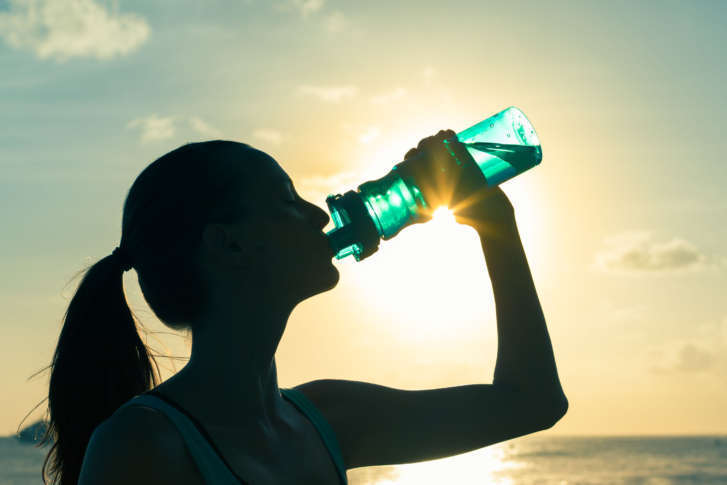WASHINGTON — Strings of 80-degree days are a familiar sight to those in the D.C. area. And while the summer’s sun and clear skies may tempt runners to take their exercise outdoors, the heat can be dangerous.
MedStar Washington Hospital Center Orthopedic Surgeon Dr. Evan Argintar has some tips for runners who are planning to run outdoors as summer’s heat takes over.

Hydrate, hydrate, hydrate
The most important thing to do is be fully hydrated, said Argintar, who is also assistant director of Sports Medicine with MedStar Orthopaedic Institute.
“You want to go into it hydrated because if you don’t, you are more likely to cramp up and get some of the other more systemic problems like heat stroke and things of that nature, and that can be really dangerous.”
Drinking water or a sports drink will work, he added.
So how much should you drink?
Hydration levels are dependent upon a runner’s size and body composition. One way to monitor is with the color of urine — as you become more hydrated, urine is lighter, he said.
(Thinkstock)
 \n","caption":"
\n","caption":"Hydrate, hydrate, hydrate\n The most important thing to do is be fully hydrated, said Argintar, who is also assistant director of Sports Medicine with MedStar Orthopaedic Institute.\n \u201cYou want to go into it hydrated because if you don\u2019t, you are more likely to cramp up and get some of the other more systemic problems like heat stroke and things of that nature, and that can be really dangerous.\u201d\n Drinking water or a sports drink will work, he added.\n So how much should you drink?\n Hydration levels are dependent upon a runner’s size and body composition. One way to monitor is with the color of urine \u2014 as you become more hydrated, urine is lighter, he said.\n (Thinkstock)\n"},{"type":"photo","media":" Know the warning signs \n Heat stroke can be deadly, so it\u2019s important to know the body\u2019s warning signs for when you\u2019re overheated.\n Fatigue and dizziness are signs to back off, said Dr. Argintar.\u00a0In some really advanced situations, runners may even stop sweating.\n \u201cSometimes the symptoms are subtle, but they should never be neglected,\u201d Argintar said.\n Hydrating is key, but if symptoms persist, it\u2019s reasonable and safe to head to an emergency room, he recommends.\n How hot is too hot to run outside? There\u2019s no hard-and-fast rule, he said, adding that everyone\u2019s body is different. It\u2019s a good idea to keep an eye on the heat indexes and be hyper aware of symptoms.\n \u201cI ask my patients \u2026 to be very honest with themselves as symptoms may evolve \u2014 to walk it or avoid or truncate a run if they\u2019re not feeling good during that event,\u201d Argintar said.\n (Thinkstock)\n"},{"type":"photo","media":" Dress for the weather\n When temperatures rise, certain clothes can help keep runners cooler.\n Dr. Argintar recommends wearing wicking fabrics, which can help decrease excess heat. The wicking materials help the body not be covered in sweaty garments \u2013 an uncomfortable situation that can impact the body\u2019s internal cooling system, he said.\n It may help to avoid darker clothing, which can retain heat, he adds.\n (Thinkstock)\n"},{"type":"photo","media":" Run at coolest times of day\n Running earlier and later in the day can help spare runners\u2019 body from the worst heat of the day.\n \u201cHigh noon \u2014 maybe that\u2019s not the best time. The reality is that sometime people have schedules that are a little bit limiting,\u201d\u00a0Dr. Argintar said.\n He recommends that if you have to run in the middle of the day, limit distance or run in shaded areas. And save those longer runs until a time when you can get out the door during the cooler morning or evening hours.\n If all else fails, take the run indoors to a treadmill.\n (Thinkstock)\n"},{"type":"ad","media":" Be aware of surroundings\n A lot of runners have logged winter miles on the treadmill and are starting to transition to outdoor miles, which require much more attention.\n Argintar tells his patients be aware of their environment when moving to more outdoor workouts. There are lots of distractions that can be covered up by head phones, such as a car honking its horn.\n Also, the change from treadmill to outdoor running can bring the potential for injuries.\n “A lot of people … aren’t used to hills or paying attention to curbs, and so some of those distractions can cause injury to someone who is not paying attention.”\n (Getty Images\/Hemera\/M.g. Mooij)\n"},{"type":"photo","media":" Manage expectations\n Runners may try for certain times for speed or duration workouts, but hotter weather can dash all hopes. It\u2019s OK \u2013 and runners should reign in expectations during warmer months, Dr. Argintar said.\n \u201cThe hotter environment makes it absolutely more challenging to hit some of these milestones, so oftentimes I tell people to just adjust expectations,\u201d he said.\n (Thinkstock)\n"}], previews: [{"index":0,"src":"http:\/\/wtop.com\/wp-content\/uploads\/2017\/07\/ThinkstockPhotos-503705656-260x174.jpg"},{"index":1,"src":"http:\/\/wtop.com\/wp-content\/uploads\/2017\/07\/ThinkstockPhotos-477815606-260x174.jpg"},{"index":2,"src":"http:\/\/wtop.com\/wp-content\/uploads\/2017\/07\/ThinkstockPhotos-475382348-260x174.jpg"},{"index":3,"src":"http:\/\/wtop.com\/wp-content\/uploads\/2015\/08\/fitness_walking_ts-260x174.jpg"},{"index":5,"src":"http:\/\/wtop.com\/wp-content\/uploads\/2017\/06\/ThinkstockPhotos-99340669-260x174.jpg"},{"index":6,"src":"http:\/\/wtop.com\/wp-content\/uploads\/2017\/07\/ThinkstockPhotos-491249122-260x174.jpg"}], prev: "\t", next: "\t" };
The post Tips for running in summer’s heat appeared first on WTOP. \n","caption":"
\n","caption":" \n","caption":"
\n","caption":" \n","caption":"
\n","caption":" \n","caption":"
\n","caption":" \n","caption":"
\n","caption":"

